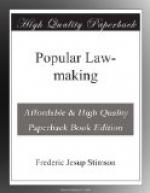This doctrine of conspiracy is so old in England that I am unable to trace it to its source. From the wording of repeated early statutes it would seem that they recognized this law of conspiracy as already existing and merely applied it to new forms, such as, for instance, the combination of masons, carpenters, and guilds, just mentioned. It is, perhaps, not to us important whether it is originally based on common law or these early statutes, for these statutes are quite early enough to have passed into the common law of England, and consequently into the common law in this country. Moreover, early statutes merely express the common law; therein lies their significance. Now, many State laws and constitutions, as well as most State courts, recognize that the common-law statutes of England existing at least before 1775, if not 1620,[1] are common law in the States of this Union. In a general way, any statute that antedates the time of our settlement we took over as part of our common law.
[Footnote 1: 1607 (Virginia, West Virginia, Illinois, Indiana, Missouri, Arkansas, Colorado, Wyoming); 1776 (Florida, Maryland, Rhode Island, Pennsylvania). None, however, are law in New York.]
We are now coming also to that great range of statutes, which, on the one hand, control labor and regulate the rights of the laborer, both in his prices and in his hours; and, on the other, those statutes relating to what we call “trusts,” conspiracy, and trades-unions, which have made common-law principles which are to-day, all of them, invoked by our courts; and form the precedents of practically all our modern legislation on matters affecting labor, labor disputes, injunctions, strikes, boycotts, blacklists, restraint of trade, and trusts—in fact, the largest field of discussion now before the mind of the American people. The subjects are more or less connected. That is, you have the growth of legislation as to laborers on the one hand, and on the other you have the growth of this legislation as to combinations or conspiracies, trades-unions, guilds, etc.




